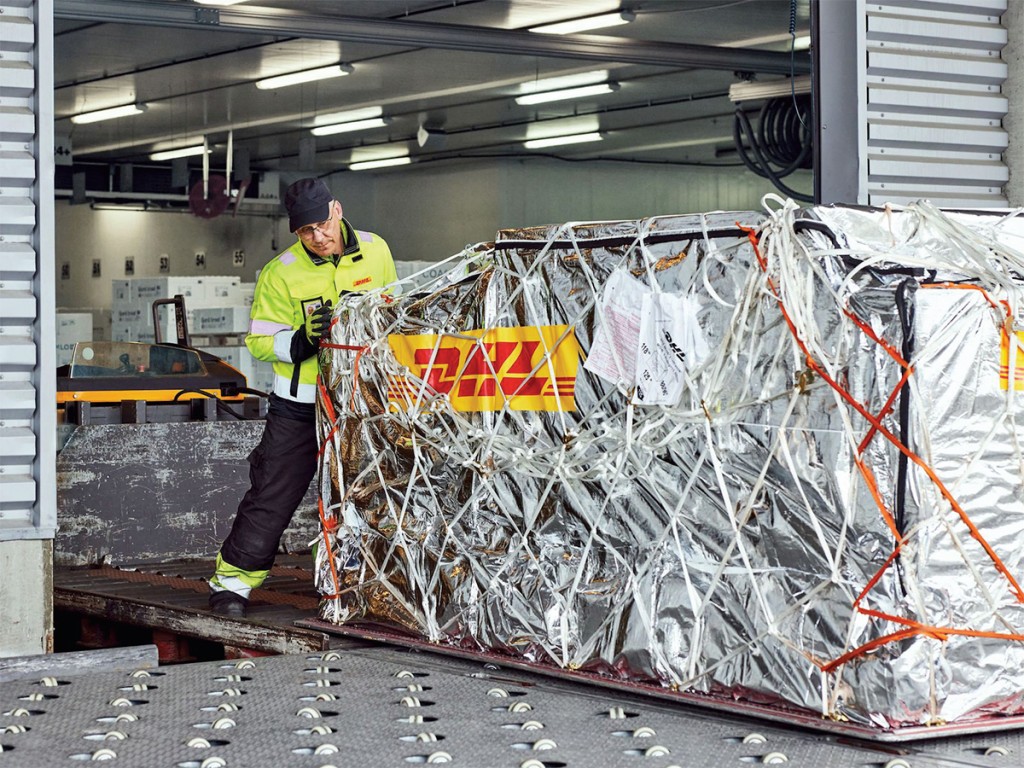DHL Forwarding’s (DGF) is laser focused on the demanding logistics of the most time sensitive of all perishables — pharmaceuticals.
Over the years, DHL has built a worldwide reputation for speed in shipping everything from documents to project cargoes, but since 2020, its DHL Global Forwarding (DGF) business unit has been laser focused on one of the most time sensitive of all perishables—epidemic fighting pharmaceuticals.
DGF is no stranger to the demanding, rapidly growing health care commodities sector. Its corporate sibling, DHL Express with its distinctive canary yellow jets and trucks, have been delivering medicines and medical devices domestically and globally as quickly as the same day they were shipped.

COVID 19 Tests Supply Chain
But when the COVID 19 pandemic struck internationally, the 600,000-person transportation company, said to be the largest in the world, had the capacity, infrastructure, manpower and experience to become an important link in the global supply chain for COVID vaccines.
Patricia “Patti” Cole, who is global head of both the DGF Same Day team and the DGF Temperature Management Solutions team, based in Sterling, Virginia, is quick to point out that transporting COVID vaccines is an “initiative within the pharma sector” and was not an instant global rollout.
Transportation is only part of the challenge of moving delicate vaccines, Cole told the American Journal of Transportation in an exclusive interview. Packaging availability combined with “the coordination and handling of the COVID 19 vaccines has prepared our team for complex handling of upcoming pharmaceutical shipments with similar temperature ranges and handling requirements,” she says.

Quilted Thermal Blankets
The DGF executive declines to identify “several major shippers” the forwarder is currently working with in transporting from the U.S. to Europe. But she candidly explains that the pharmaceuticals do not move in just any climate-regulated container. DGF’s logistical solution is far more innovative and refined.
“We’ve been promoting the use of quilted thermal blankets for pharma clients that usually require active electric containers to keep a stable environment for their products,” she explains. “The use of thermal blankets is applied in controlled environments that do not have long tarmac exposures. This is used along with temperature-controlled storage and build-up on the ground combined with aircrafts that have the ability to maintain +2C-8C while in flight.”
Cole further says the “benefits to the usage of the thermal blankets is many including cost-effectiveness in the space gained and the reduction in (container) lease costs, sustainability in the reuse of the product and reduction of CO2 emissions owing to fewer trucking hauls.” In short, she maintains, the procedure creates a “very controlled environment end to end --from origin, through flight to destination.”
Moreover, the thermal blanket-wrapped and temperature-controlled containers are not just loaded on the airplane as freight. Each blanket is pre-conditioned to sustain the temperature range for the duration of the transport.
Cole says the entire payload is analyzed beforehand to avoid a “temperature excursion where the transport temperatures have exceeded the tolerance range.”
Then a specific route or lane is flown on the transatlantic flight to further ensure predetermined temperature control. “With the thermal blankets, we’ve had zero temperature excursions in the last seven months,” she adds, and that includes export and import flights.
Aircraft Temperature Controlled
Interestingly, the entire aircraft is temperature-controlled, says Cole, so the thermal wrapped cargoes in the specialized containers can be loaded on the main or lower deck of an aircraft. With the various logistic and sustainability benefits of the DGF thermal program, she says, the shipper can realize approximately a minimum of 25% savings in transportation costs.
Within a month, DHL is going to explore expanding the thermal wrapped pharmaceutical program beyond Europe. “We’re going to start doing trials to see if we can bring it to a transpacific route,” contends Cole. However, she will not identify specifics such as the pharma company shippers, their forwarders, transpacific route flown or the origin and destination airports.
“To set and maintain a controlled environment, you must have the proper (warehouse) facility, build-up area and you cannot have extended tarmac times,” says the DGF executive.
DHL Global Forwarding has recently been investing extensively in air freight ground facilities with temperature-control capabilities. “We have a premier 161,000 square-foot facility, of which over 4,000 square feet is dedicated to pharma temperature-controlled products near the Miami International Airport that is only several years old,” contends Cole.
Latin America
DHL is focusing on Latin America, a busy perishables and pharma origin and destination, to further house temperature sensitive commodities. Its Costa Rica facility currently has over 50,000 square meters of bonded and general warehousing space that includes temperature-control solutions for both +15C to 25C and +2C to 8C. This year, the carrier is adding over 60,000 square meters of bonded and general warehouse storage.
Yet these specialized DHL warehouses provide more than just storage, emphasizes Cole. Included are value added services such as inventory management, planning, control labeling, repackaging, rebranding and distribution strategies for medicines and medical devices.
Looking ahead, Cole says “we’re still seeing spots of softness in the market from an air freight perspective. There is a spike in e-commerce which is driving the transpacific lanes and that will be a continuing trend for at least throughout this year. Currently, the Red Sea situation is leading to some conversion to air freight in certain lanes.”

Follow us on social media: